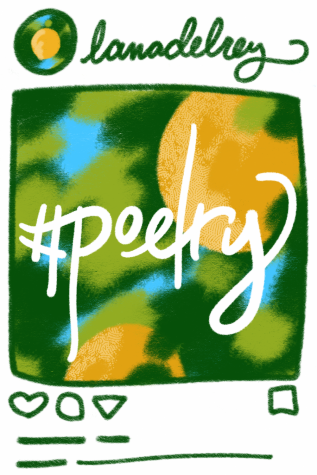“Violet” in review: Is Lana Del Rey a poet?
October 15, 2020
If you imagine a book of poetry written by a heartbroken, sentient butterfly, you have a pretty good feel for Lana Del Rey’s first book of poetry, “Violet Bent Backwards Over The Grass.” The collection, released in print on Sept. 29, has its strong points, and certainly no one can deny that Del Rey wrote a book that is, technically, poetry. But the question looms: Is Lana Del Rey a capital-P Poet?
Typically, I wouldn’t approach art in this manner. I firmly believe that if a piece of art speaks to you, then your enjoyment itself makes that piece of art worthwhile. However, in a single book, Del Rey mentions writing or outright proclaims herself a “real poet” 29 times (yes, I counted). If Del Rey wants to claim the title, readers have to hold her to it.
The strongest out of the collection, “LA Who am I to Love You?,” makes a solid case for at least some poetic skill. Del Rey translates her ethereal, melodramatic persona onto the page and writes with an alluring childish wonderment. She uses repetition, rhyme and the affectionate nickname “LA” to create a surprisingly cohesive, convincing love letter. This poem is successful because it’s one of the few where Del Rey writes about someone or something other than herself, while still maintaining her trademark narcissistic aesthetic.
The less strong majority of the collection, however, comes off as trite, affectatious and desperate to convince the reader that she is a poet. Except for the series of Instagram-caption-like haikus, the book is free verse, a form not confined to regular meter or rhythm. This particularly draws out her inattention to the genre of poetry, since the challenge of free verse is that the writer must understand form enough to write without it. Without a set form or sophisticated understanding of form, Del Rey’s poetry comes off as juvenile, as though she decided to insert enigmatic line-breaks into diary entries and call it poetry.

I spoke about the book with Adam Gordon, Whitman Associate Professor of English, who specializes in early and nineteenth-century American literature and regularly teaches poetry courses. Gordon said, “You want to feel like abstract painters have mastered some of the more classical aspects of craft before they just present a white canvas and say, ‘Here’s my masterpiece.’ I wonder, could Del Rey write a sestina? If you asked her what a sestina was, could she tell you? If she’s ardently embracing the term ‘poet,’ what kind of a student of poetry has she been?”
Del Rey tries to show that she’s familiar with great writers who preceded her by evoking Sylvia Plath, Robert Frost, William Faulkner, Allen Ginsberg, Shakespeare, and Bob Dylan, but these references are surface-level. For example, the line, “Stay on your path Sylvia Plath,” from the poem “Bare feet on linoleum” has little resonance beyond the similar sounds of “path” and “Plath.” Del Rey’s references contribute to her nostalgic aesthetic more than her status as a poet.
To answer my initial question: No, Lana Del Rey is not a Poet.
But, just to throw a wrench in things, what if we ignore her blatant authorial intent and stop looking for Lana Del Rey the Poet? Without the pretext that Del Rey wants to sit with the likes of Dylan and Whitman, she actually uses some fascinating techniques that make the book worthwhile.
For example, Del Rey utilizes Gen Z culture in a way that has the potential to reassure a young audience that their interests are worthy of appearing in poetry. Her poem “What happened when I left you” incorporates a watermelon emoji, which is not a new concept, but it is a nontraditional way of writing that will undoubtedly reach a larger audience than contemporary emoji poets. Similarly, Del Rey sometimes replaces “you” with “u” and “with” with “w,” which is also not new, but may introduce young readers to the idea that poetry doesn’t have to be written in traditional, formal language.
Whether the type of poetry inspired by Del Rey’s collection would be sophisticated or not, we probably already know. But there’s always hope that literature designed to appeal to young people will inspire them to seek out writers like the ones Del Rey references. Readers who glimpse the copy of “Howl” by Allen Ginsberg in the picture opposite Del Rey’s poem “ringtone,” and subsequently decide to seek it out, may be in for quite a shock. But despite the chasm between the two writers, I can’t help but delight over the thought of an inspired teenager who just discovered emoji poetry and Allen Ginsberg.
Maybe I’m too optimistic, but there is undoubtedly something uniquely Lana Del Rey about publishing a book with a selfie on the back cover and using her favorite poetic lines as her Instagram bio (“My life is my poetry / My lovemaking is my legacy”). Arguably, “Violet Bent Backwards Over The Grass” could be a cultural artifact if the expectation of authentic, serious art didn’t loom over it so heavily.
If you’re looking to read capital-P Poetry, this book isn’t for you. But, if you’re like me and find something alluring and funny about juxtaposing Robert Frost with athleisure wear, Del Rey’s book might provide some amusement. At the very least, the collection gives us food for thought about what it means to write poetry for young people in the 21st century.






LanaDelSlay • Feb 16, 2022 at 10:10 am
You thought you ate….
lanita_is_bonita • Jul 7, 2023 at 9:26 pm
LMAOO REAL